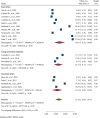Diagnostic accuracy of MUAC for assessment of acute malnutrition among children aged 6-59 months in Africa: systematic review and meta-analysis
- PMID: 40129662
- PMCID: PMC11930825
- DOI: 10.3389/fnut.2025.1536386
Diagnostic accuracy of MUAC for assessment of acute malnutrition among children aged 6-59 months in Africa: systematic review and meta-analysis
Abstract
Background: Mid-Upper Arm Circumference (MUAC) or Weight-for-Length Z-Score (WHZ) are used to screen for acute malnutrition in children. The relative merits of MUAC and WHZ, as well as whether they ought to be used separately, are still up for debate. Considering the significant impact of acute malnutrition on a large number of children in Africa, along with the constraints on resources, it is crucial to critically assess the validity of simple and widely used tools utilized in both African communities and clinical settings. Therefore, this study aimed to assess the diagnostic test accuracy of MUAC in screening acute malnutrition among children aged 6-59 months in Africa.
Methods: A systematic review and meta-analysis study was conducted to pool evidence on the diagnostic performance of MUAC compared to WHZ among children aged 6 to 59 months across various studies in Africa. The StataMP 17.0 software was utilized for analysis, employing a Bivariate Random-effects Meta-Analysis model. Sensitivity, specificity, the Diagnostic Odds Ratio, and the Area Under the Curve were calculated. Heterogeneity was assessed using Cochrane's Q statistic and the I2 test. Additionally, meta-regression, subgroup analysis, sensitivity analysis, and assessments for publication bias were employed. The overall level of diagnostic test accuracy was estimated using a random-effects meta-analysis model.
Results: Seventeen studies were included in the meta-analysis. The pooled sensitivity and specificity were 38.1% (95% CI: 30.7, 46.1%) and 94.9% (95% CI: 93.2, 96.2%), respectively. The summary receiver operating characteristic curve plot showed that MUAC had good accuracy in detecting acute malnutrition (AUC = 0.85, 95% CI: 0.82, 0.88). The pooled level of diagnostic odds ratio was 13.22 (95% CI: 9.68, 16.77). The rate of misclassification in screening for acute malnutrition using MUAC was observed to be 11.7%.
Conclusion: The MUAC demonstrated low sensitivity but high specificity in diagnosing acute malnutrition in children aged 6 to 59 months across various regions of Africa. Furthermore, it was found that MUAC provides good diagnostic test accuracy when compared to WHZ. To enhance its accuracy, it is suggested to increase the MUAC cutoff thresholds.
Keywords: Africa; MUAC; WHZ; acute malnutrition; children; diagnostic accuracy; validation.
Copyright © 2025 Menber, Belachew and Fentahun.
Conflict of interest statement
The authors declare that the research was conducted in the absence of any commercial or financial relationships that could be construed as a potential conflict of interest.
Figures











Similar articles
-
Accuracy of Mid-Upper Arm Circumference for Detecting Acute Malnutrition in Children Aged 6-59 Months in an Urban Slum in Bangladesh: A Cross-Sectional Analysis.Cureus. 2022 Dec 30;14(12):e33137. doi: 10.7759/cureus.33137. eCollection 2022 Dec. Cureus. 2022. PMID: 36726922 Free PMC article.
-
Diagnostic Accuracy of Mid-Upper Arm Circumference for the Detection of Acute Malnutrition Among Children Aged 6-60 Months: A Diagnostic Accuracy Study.J Res Health Sci. 2024 Jun 1;24(2):e00612. doi: 10.34172/jrhs.2024.147. Epub 2024 Jun 1. J Res Health Sci. 2024. PMID: 39072548 Free PMC article.
-
Arm circumference for age, arm circumference and weight-for-height z-score for the evaluation of severe acute malnutrition: a retrospective cohort study in eastern Democratic Republic of Congo.BMC Public Health. 2024 Feb 23;24(1):587. doi: 10.1186/s12889-024-18083-y. BMC Public Health. 2024. PMID: 38395784 Free PMC article.
-
Severely malnourished children with a low weight-for-height have similar mortality to those with a low mid-upper-arm-circumference: II. Systematic literature review and meta-analysis.Nutr J. 2018 Sep 15;17(1):80. doi: 10.1186/s12937-018-0383-5. Nutr J. 2018. PMID: 30217196 Free PMC article.
-
Feasibility and diagnostic accuracy of neonatal anthropometric measurements in identifying low birthweight and preterm infants in Africa: a systematic review and meta-analysis.BMJ Paediatr Open. 2024 Oct 1;8(1):e002741. doi: 10.1136/bmjpo-2024-002741. BMJ Paediatr Open. 2024. PMID: 39353710 Free PMC article.
References
-
- Custodio E, Mwirigi L, Tefera N, Perez-Hoyos A, Baille B, Nyawo M, et al. . Assessing the use of acute malnutrition indicators for nutrition surveillance: Results from 682 283 child observations in 27 low-and middle-income countries (2022). Available online at: https://repisalud.isciii.es/rest/api/core/bitstreams/245db118-7fec-4acf-... (Accessed 15 October 2024).
-
- Grellety E, Golden MH. Weight-for-height and mid-upper-arm circumference should be used independently to diagnose acute malnutrition: policy implications. BMC Nutr. (2016) 2:10. doi: 10.1186/s40795-016-0049-7 - DOI
-
- World Health Organization . Guideline: Updates on the management of severe acute malnutrition in infants and children: World Health Organization; (2013). Available online at: https://iris.who.int/bitstream/handle/10665/95584/9789241506328_eng.pdf?.... (Accessed 20 February 2024) - PubMed
-
- World Health Organization . WHO child growth standards and the identification of severe acute malnutrition in infants and children: Joint statement by the World Health Organization and the United Nations Children’s fund. (2009). Available online at: https://iris.who.int/bitstream/handle/10665/44129/9789241598163_eng.pdf?... (Accessed 23 February 2024). - PubMed
-
- Gibson RS. Principles of nutritional assessment. USA: Oxford University Press; (2005).
Publication types
LinkOut - more resources
Full Text Sources

